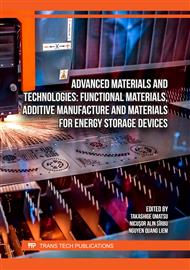[1]
M. Hu, X. Hu, G. Wang, Y. Cheng, X. Yu, X. Huang, A fluorescent lateral flow immunoassay based on CdSe/CdS/ZnS quantum dots for sensitive detection of olaquindox in feedstuff, Food Chem., 419 (2023) 136025.
DOI: 10.1016/j.foodchem.2023.136025
Google Scholar
[2]
G. Devatha, S. Roy, A. Rao, A. Mallick, S. Basu, P. P. Pillai, Electrostatically driven resonance energy transfer in "cationic" biocompatible indium phosphide quantum dots, Chem. Sci., 8 (2017) 3879-3884.
DOI: 10.1039/c7sc00592j
Google Scholar
[3]
M. Noh, T. Kim, H. Lee, C.-K. Kim, S.-W. Joo, K. Lee, Fluorescence quenching caused by aggregation of water-soluble CdSe quantum dots, Colloids Surf. A Physicochem., 359 (2010) 39-44.
DOI: 10.1016/j.colsurfa.2010.01.059
Google Scholar
[4]
S. Yamashita, M. Hamada, S. Nakanishi, H. Saito, Y. Nosaka, S. Wakida, V. Biju, Auger Ionization Beats Photo-Oxidation of Semiconductor Quantum Dots: Extended Stability of Single-Molecule Photoluminescence, Angew. Chem. Int. Ed., 23 (2023) 3892-3896.
DOI: 10.1002/anie.201501131
Google Scholar
[5]
K. Cendrowski, P. Sikora, B. Zielinska, E. Horszczaruk, E. Mijowska, Chemical and thermal stability of core-shelled magnetite nanoparticles and solid silica, Appl. Surf. Sci., 407 (2017) 391-397.
DOI: 10.1016/j.apsusc.2017.02.118
Google Scholar
[6]
M.A. Malvindi, V. Brunetti, G. Vecchio, A. Galeone, R. Cingolani P. P. Pompa, SiO2 nanoparticles biocompatibility and their potential for gene delivery and silencing, Nanoscale, 4 (2012) 486-495.
DOI: 10.1039/c1nr11269d
Google Scholar
[7]
L. M. Liz-Marzán, M. Giersig, P. Mulvaney, Synthesis of Nanosized Gold-Silica Core-Shell Particles, Langmuir, 12 (1996) 4329-4335.
DOI: 10.1021/la9601871
Google Scholar
[8]
S.Winardi, L. Qomariyah, W. Widiyastuti, K. Kusdianto, T. Nurtono, S. Madhania, The role of electro-sprayed silica-coated zinc oxide nanoparticles to hollow silica nanoparticles for optical devices material and their characterization, Colloids Surf. A Physicochem., 604 (2020) 125327.
DOI: 10.1016/j.colsurfa.2020.125327
Google Scholar
[9]
K.-P. Chang, C.-J. Wu, C.-W. Lo, Y.-S. Lin, C.-C. Yen, D.-S. Wuu, Synthesis of SiO2-coated CdSe/ZnS quantum dots using various dispersants in the photoresist for color-conversion micro-LED displays, Mater. Sci. Semicond. Process., 148 (2022) 106799.
DOI: 10.1016/j.mssp.2022.106790
Google Scholar
[10]
Y. Kobayashi, H. Inose, T. Nakagawa, K. Gonda, M. Takeda, N. Ohuchi, A. Kasuya, Control of shell thickness in silica-coating of Au nanoparticles and their X-ray imaging properties, J. Colloid Interface Sci., 358 (2011) 329-333.
DOI: 10.1016/j.jcis.2011.01.058
Google Scholar
[11]
Y. Kobayashi, M. Horie, M. Konno, B. R.-González, L. M. L.-Marzán, Preparation and Properties of Silica-Coated Cobalt Nanoparticles, J. Phys. Chem., 107 (2003) 7420-7425.
DOI: 10.1021/jp027759c
Google Scholar
[12]
Y. Kobayashi, K. Misawa, M. Takeda, M. Kobayashi, M. Satake, Y. Kawazoe, N. Ohuchi, A. Kasuya, M. Konno, Silica-coating of AgI semiconductor nanoparticles, Colloids Surf. A Physicochem. Eng. Asp., 251 (2004) 197-201.
DOI: 10.1016/j.colsurfa.2004.10.007
Google Scholar
[13]
Y. Kobayashi, K. Misawa, M. Kobayashi, M. Takeda, M. Konno, Silica-coating of fluorescent polystyrene microspheres by a seeded polymerization technique and their photo-bleaching property, Colloids Surf. A Physicochem. Eng. Asp., 242 (2004) 47-52.
DOI: 10.1016/j.colsurfa.2004.04.052
Google Scholar
[14]
M. Yokokawa, T.-t. Li, M. Kambayashi, K. Nakashima, Y. Hirayama, H. Okura, M. Hasegawa, S. Dertinger, Y. Kobayashi, Silica-coating of quantum nanorods by a sol–gel process and their photo-bleaching properties, J. Solgel Sci. Technol., 86 (2018) 773-781.
DOI: 10.1007/s10971-018-4674-2
Google Scholar
[15]
M. Kambayashi, N. Yamauchi, K. Nakashima, M. Hasegawa, Y. Hirayama, T. Suzuki, Y. Kobayashi, Silica coating of indium phosphide nanoparticles by a sol-gel method and their photobleaching properties, SN Appl. Sci., 1576 (2019).
DOI: 10.1007/s42452-019-1635-5
Google Scholar
[16]
W. Sung, Y.-L. Lo, Ammonia vapor sensor based on CdSe/SiO2core–shell nanoparticles embedded in sol-gel matrix, Sens. Actuators B Chem., 188 (2013) 702-708.
DOI: 10.1016/j.snb.2013.07.040
Google Scholar
[17]
T.N.M. Bernards, M.J. van Bommel, A.H. Boonstra, J. Non Cryst. Solids, 134 (1991) 1-13.
Google Scholar
[18]
R. Koole, P. Liljeroth, C. M. Donegá, D. Vanmaekelbergh, A. Meijerink, Electronic Coupling and Exciton Energy Transfer in CdTe Quantum-Dot Molecules, J. Am. Chem. Soc., 32 (2006) 10436-10441.
DOI: 10.1021/ja061608w
Google Scholar
[19]
Y. Zhang, L. Mi, P.-N. Wang, J. Ma, J.-Y. Chen, pH-dependent aggregation and photoluminescence behavior of thiol-capped CdTe quantum dots in aqueous solutions, J. Lumin., 128 (2008) 1948-1951.
DOI: 10.1016/j.jlumin.2008.06.004
Google Scholar
[20]
T.Ung, L. M. L.-Marzán, P. Mulvaney, Controlled Method for Silica Coating of Silver Colloids. Influence of Coating on the Rate of Chemical Reactions, Langmuir 14 (1998) 3740-3748.
DOI: 10.1021/la980047m
Google Scholar
[21]
W. Stober, A. Fink, Controlled Growth of Monodisperse Silica Spheres in the Micron Size Range, J. Colloid Interface Sci., 26 (1968) 62-69.
DOI: 10.1016/0021-9797(68)90272-5
Google Scholar



